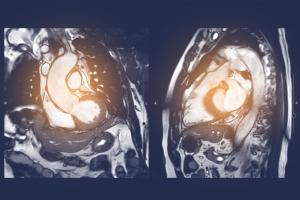
While the danger of carrying too much fat around the waist and hips is well known, UVA Health scientists are developing a noninvasive way to assess the risks of fat surrounding the heart.
The researchers, led by the University of Virginia Department of Biomedical Engineering’s Frederick H. Epstein, developed an innovative way to use magnetic resonance imaging, or MRI, to assess the composition of adipose tissue – fat – surrounding the heart. That test could help identify patients at greatest risk for potentially deadly cardiac problems such as coronary artery disease, atrial fibrillation (irregular heartbeat) and heart failure, and predict how patients may respond to treatment.

The Department of Biomedical Engineering is a joint program of the School of Medicine and the School of Engineering and Applied Science.
“For the first time, we have the ability to know the composition of the fat that accumulates around the heart. This is important because, depending on its makeup, the fat that surrounds the heart has the potential to release damaging substances directly into the heart muscle, leading to serious heart problems,” said Dr. Amit R. Patel, a cardiologist and imaging expert at UVA Health and the School of Medicine.
“We’re excited to partner with cardiologists like Dr. Patel to explore clinical applications of this method, and hope that this method ultimately leads to more precise treatments and better outcomes for patients with heart disease,” Epstein said.
Patel said researchers hope to find ways to convert the unhealthy fat surrounding the heart to a healthier type of fat through diet, exercise or medication.
The Heart of the Matter
A layer of fat known as “epicardial adipose tissue” naturally surrounds the heart. In healthy people, this fat is protective and vital for heart function. In some individuals, especially those with obesity and risk factors for heart disease such as diabetes, high blood pressure, smoking and a poor diet, this fat can build up excessively, becoming inflamed and undergoing harmful changes in its composition.
The MRIs would let doctors see inside the body without surgery. By analyzing the amounts of saturated fatty acids, monosaturated fatty acids and polyunsaturated fatty acids, doctors could be able to identify patients who could face heart problems before symptoms appear. Identifying and correcting this problem has the potential to slow down the progression of heart disease, the No. 1 cause of death in the United States and around the world.
That suggests that this new MRI technique could become a useful clinical tool for identifying at-risk patients and predicting their outcomes,” Patel said. “Being able to see the composition of the fat that surrounds the heart will improve our understanding of heart disease and may lead to the development of new treatment strategies in the future.”
Published Research
The research was supported by the National Institutes of Health’s National Heart, Lung and Blood Institute, grant R01HL162872; the National Institute on Aging, grant R01AG076360; the American Heart Association, grant 23PRE1011202; and the National Institutes of Health, grant T32HL007284.